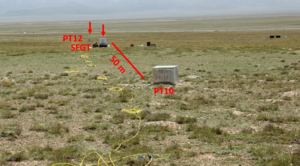Annualmeeting:2017 CSDMS meeting-120
Browse abstracts
Very Fine Scale of Permafrost Distribution and Controlling Factors
[[Image:|300px|right|link=File:]]Besides long-term monitoring in changes of thermal state of permafrost and active layer thickness, the knowledge of permafrost distribution at very fine scales (tens of meters) in discontinuous permafrost is still largely unknown in Qinghai-Tibet Plateau (QTP). A permafrost island was found by using geophysical investigations in the Heihe River Basin in northeastern QTP. Permafrost island was present at PT10 site beneath alpine steppe and coarse soil with a quality of gravel in surface soil (Fig. 1, Fig. 2). In contrast, permafrost is absent at SFGT site with density land cover area and relatively less gravel. The results showed that the ground surface temperature (5 cm) at PT10 site is lower in winter and higher in summer than the SFG site. The presence of permafrost is caused by soil conditions, especially by high thermal conductivity, based on field investigations. To address the controlling factors of permafrost presentences a 1D heat transfer model is used to compare the ground temperature difference between these two sites by only changing the soil conditions.


